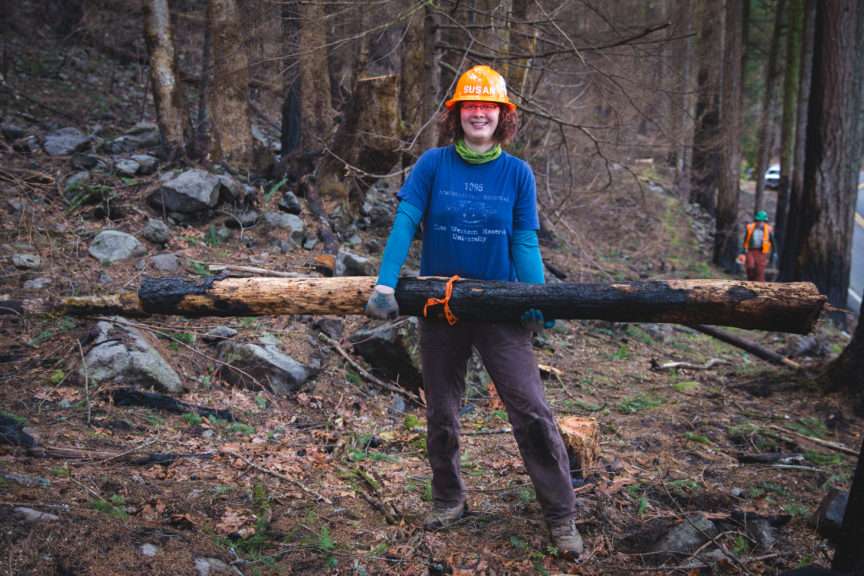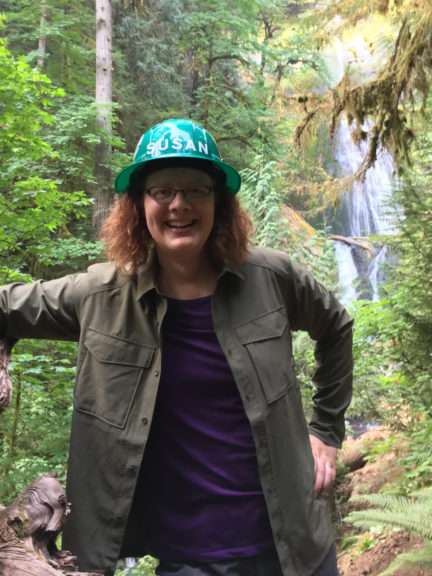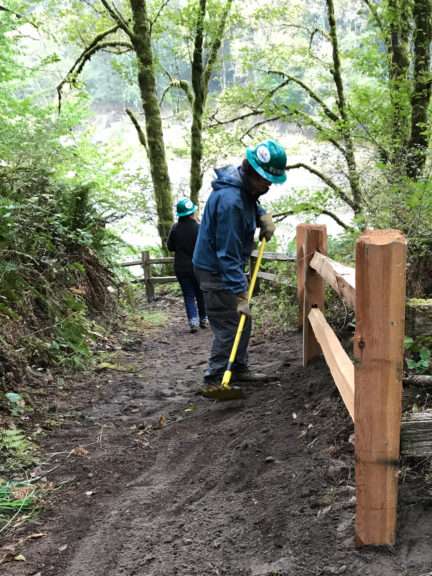By Greg Lief Greg Lief is the creator and curator of OregonWildflowers.org, a resource to help wildflower lovers find great Pacific Northwest wildflower locations and the best times to visit. Lief offers the following tips to improve your…
By Michael McDowell, Newsletter Editor, Trailkeepers of Oregon
Susan Schen grew up in Northeast Ohio among deciduous hardwood forests and, as she says, “not a lot of elevation gain in hiking.” When she lived in Seattle for a year, she “just kind of fell in love with” the Pacific Northwest. She started volunteering with Trailkeepers of Oregon in the fall of 2016 after moving to Portland and is now a trail crew leader. Michael McDowell and John Sparks sat down with Susan on a morning in February to talk about her experiences with trail work.

Susan working on fire-damaged trail in the Gorge. (Photo by Megan Zabel Holmes)
How did you get started doing trail work?
I was in graduate school back in western Massachusetts at the Conway School of Landscape Design. We had a half day and full day of workshop on trail design. I was like wow, this is really fun. On the half day I was just in the classroom learning about the specifications for sustainable trails, guidelines, and stuff like that. And then we spent a day outside, with clinometers, routing trails through the woods. It was really, really fun. Immediately after completing my degree, my wife and I moved to Portland where I started looking for opportunities to learn more about trail construction. I figured, what better way to learn about designing trails than actually going out and learning how they’re built? There’s nothing worse than a designer who doesn’t know how things actually happen on the ground—it tends to make it hard for everybody. That search brought me to TKO.

Susan in high spirits by Pup Creek Falls on an overnight work party on the Clackamas River Trail. (Photo by Geri Marz)
What was the process you went through to become a crew leader?
I went scouting at Oxbow Regional Park with Steve Kruger, our executive director, and he started pitching the idea of me starting to lead crews. I was like, “Wow, that really sounds like fun. How do we have that happen?” I think I led my first work party in August of 2017. That was at Oxbow. I co-crew-led with Steve. We had two youth groups there at the same time, so we had thirty-plus people. He took one of the groups and I took the other one. So I got an orange hat—an orange hard hat is worn by assistant crew leaders—and started assistant-leading with Pat and Elaine [Keavney] on Tuesdays. They are the crew leaders that I’ve learned the most from. In the crew leader manual there’s information on specific things you need to do to be eligible to become a crew leader; my process was kind of more organic.
What’s it been like, being a crew leader?
I’m a detail-oriented perfectionist in some ways. I don’t want to say I’m always that way because then it’s like, “Why didn’t you do that right?” It’s challenging to take on something new that I’m not going to be an expert at right away, but it’s exciting. I’ve really found that trail work is something that I love, and being able to teach new people about it and shape the work day as I want it to be is a really cool experience and privilege. The timing has been amazing in that I get to lead work crews in the fire-affected area in the Gorge. It’s mind-blowing. If someone asked me ten years ago, “What you think you’ll be doing in 2018?” I definitely wouldn’t have said, “leading trail stewardship crews to repair and restore trails after a fire in the Columbia River Gorge.” It’s been really cool.
Can you tell us what your experience has been in the Gorge, since you’re one of the first to be in there?
It’s really interesting. The amount of damage on the different trails varies quite a bit. When we scouted Ainsworth State Park, there were a lot of downed trees and rocks that had rolled onto the trail, but in general the fire damage was—I’m no judge of fire damage—maybe moderate. The tree trunks were scorched, maybe ten or fifteen feet high, but the canopy was intact. So it looks like the area may recover fairly quickly. In fact yesterday, we saw sword ferns that were recovering from their charred stumps and sprouting new leaves. We actually saw a trillium emerging from the soil as well, along with a bunch of fungus and other plants. One of the other crew members saw a tree frog. Definitely life is recovering. To contrast with that, I hiked scouting the Upper McCord Creek trail and the damage was far worse there above Elowah Falls. There were trees that were burned much higher where the canopy had died. That’ll take a lot longer to recover. And there are sections of the switchbacks that are covered in six feet of rock and debris and there are much larger trees down. It’ll take a lot longer to work on that. It’s interesting going on each different trail and seeing the different types of damage based on the intensity of the fire and the geology, like how steep a rock cliff is. It’s sad what’s happened with the fire, but it does present us with an opportunity to give these trails some love, where we haven’t had the resources to do ordinary maintenance, like removing the slough and berm on the trails that are otherwise in decent shape.

Susan’s first lesson on the crosscut saw, during a workday on the Latourell Falls Trail. (Photo by Michael Hoch)
Is there a particular kind of trail tool that you like working with?
I like the Pulaski a lot. It just looks really cool. The Pulaski is a two-headed tool that’s got an axe on one side of the head and a narrow adze on the other. It’s great for getting rocks away from roots and for chopping roots in the ground where you don’t want to dull your primary axe. It’s a pretty versatile tool. You can use it to do tread work in a pinch. It’s somewhere between a pick mattock and a grubber. You can actually dig down into the rocks with it if you want to. I like that one a lot.
Is there a particular kind of trail work that you like?
I like to do the technical work, although I haven’t really developed those skill sets too far yet. What I do really like doing right now that I have some skill in is decommissioning—when we do a reroute, we have to hide the original trail so that hikers take the new correct route instead of the old one. I like the artistic challenge of presenting a barrier while making it look like that barrier has always been there. I really find that satisfying, when you can walk up to that and be like, “Wait, there was a trail here?”

Susan tidies tread after installing new fence at Oxbow Regional Park. (Photo by Elaine Keavney)
Any other things that you’ve learned by being on trail crews that you hadn’t learned beforehand?
Definitely. You know it’s easy to write some guidelines down and say, “Slope the trail to the side, five to ten percent.” It’s an entirely different issue when you’re working in clay soil in the rain and every step you take puts a big footprint in the trail that fills with water immediately. There are some things that you just can’t do in some conditions. I think that’s something that I’ve learned, in particular working at Milo McIver Park, where we’ve been doing some reroutes. The soil there is the heavy clay that doesn’t drain very well. For those situations you have to go above and beyond the design parameters. I also learned about the different ways in which trails degrade with wear and tear, especially with the human impact. You may design a trail that slopes to drain water, and then once everyone starts walking on the uphill side of it, it gets tamped down and doesn’t drain anymore. The fact is that you can’t just build a trail and leave it and say, “I’m done. That trail’s awesome now.” It really requires maintenance, especially in that first year afterwards when all the kinks are getting worked out. Everything that you’ve disturbed has settled and people are treading on the surface for the first time.
How much did you work on the new McIver Viewpoint Trail?
I worked on that probably, I’d say, fifteen or twenty work parties. I was there from not quite the very beginning but through to the end of it. That was a really interesting project, especially with all the curb and crib log placement to support the tread on steep slopes.
How much have you studied landscape? What is your background in landscape design?
I was an electrical engineer for fifteen years, but I’ve always wanted to do something green. It was a matter of finding the right time to leave and pursue that. While I was an engineer I took a year-long permaculture design course which I found inspiring. I left my engineering career and the Bay Area where I had been working because I met my wife and she was doing her post-doc in Seattle. We moved to Seattle and I started looking at graduate school options, but then her advisor moved his lab to Yale, so we had to move to the East Coast for a year. Before we moved, I was attending a drip-irrigation and permaculture class and I asked one of the instructors, “Hey, if I wanted to get a permaculture-based landscape design education, where would I go on the East Coast?” She said, “Oh, go to the Conway School.” It’s a nine-month intensive program that’s all project-based learning. There’s class time, but it’s all in support of the projects you’re doing. The school acts like a landscape consulting firm—they go out and get clients and the students act as the designers. During the first week of school we learned how to survey a property using a transit and rod. The second week of class you get a card with your client’s name and contact information on it and a little summary of what the school has negotiated with them and it’s like, “Call your client and go survey their site,” and you’re off and running. We did a design project each quarter. The fall project was an individual private landscape design. The winter one was a more regional plan, using GIS software. The spring project was kind of in between in scope—mine was an historic district’s master plan.
Have you done other volunteer work besides TKO?
I’m working with a group in my neighborhood to preserve a piece of open space. It’s been dubbed “Moreland Woods” by the residents of the neighborhood. It’s a two-acre piece of property that has two dozen mature Douglas fir trees, about fifteen of which are over a hundred feet tall. It sits at the top of the bluff above Oaks Bottom Wildlife Refuge. I’ve also volunteered with the Johnson Creek Watershed Council. I did a beaver survey last fall, where we hiked in the creek and documented signs of beaver activity. I volunteered doing some planting and maintenance of one of the properties the Crystal Springs Partnership maintains in the Crystal Springs Creek watershed. I went through the neighborhood tree steward training last fall through the Urban Forestry division of Portland Parks and Recreation. I’m in the process of taking the Master Naturalist Program training as well—I’m signed up to do the Willamette Valley ecoregion class later in the spring. There’s a forty-hours-per-year volunteer aspect to that, which TKO trail work can count toward.
You seem to be enjoying trail work now. Are you figuring out ways you can meld this into a career?
I would love to make a career out of designing and building trails. In fact, I’m going to the Sustainable Trails Conference hosted by the Professional Trailbuilders Association (PTBA) in West Virginia this spring. I’m taking a class called “Rigging for Blowdowns and Hung up Trees”—how you use rope and rigging gear to reposition trees that otherwise would be too unsafe to cut out of the way of the trail—because that just sounds really fun! They have a similar hands-on class structure to what we have at Trail Skills College locally in Cascade Locks. I went to Trail Skills College last year—I took the Basic Saw Crew on Friday, and then I took the two-day Intro to Trail Maintenance. This year I signed up to help teach the Trail Decommissioning and Wildland Restoration class. I’m excited about that one. I really enjoy the artistic aspect of decommissioning. It would be cool if TKO could either within our ranks or partnering with other organizations pair up and do restoration work at the same time as trail maintenance. I think that would be a really powerful one-two punch for our trail systems—especially given that you so often see things like blackberry patches and holly instead of Oregon grape in our parks and forests. It takes some serious volunteer person-power and muscle to make a big impact when the invasives have gotten a foothold.
Michael McDowell: michael.mcdowell@trailkeepersoforegon.org
